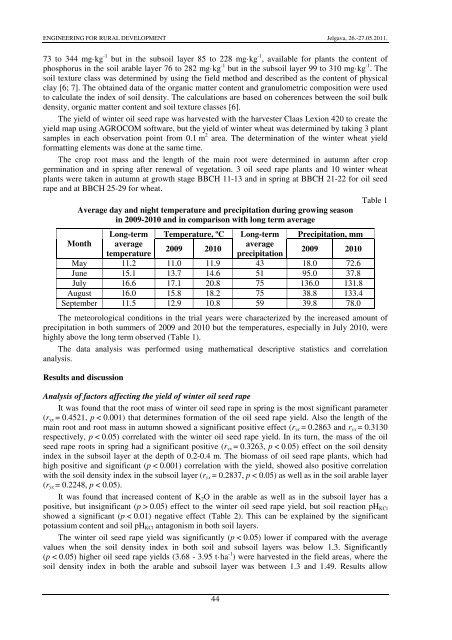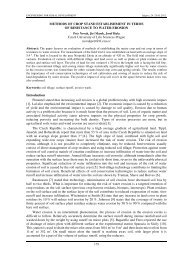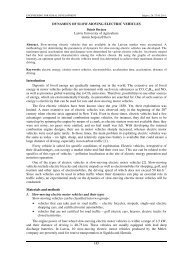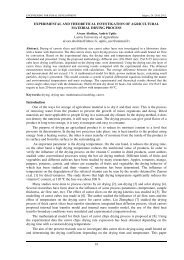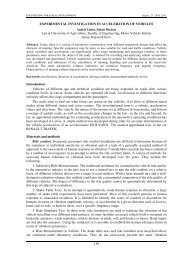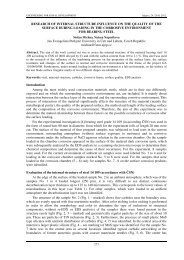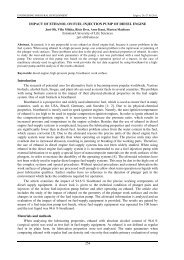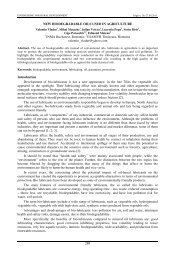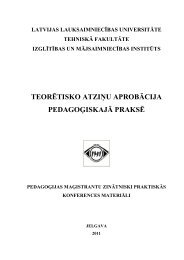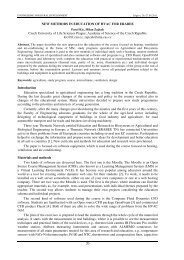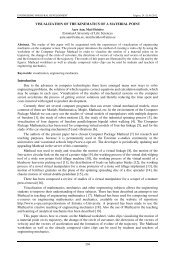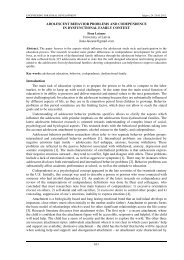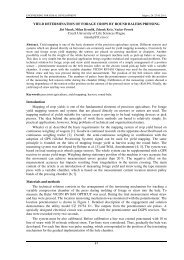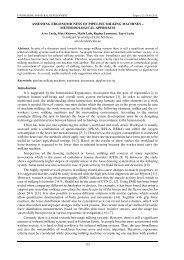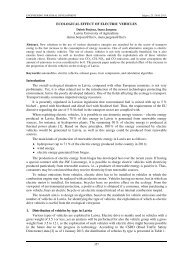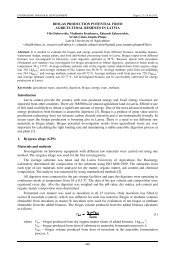Dainis Lapins, Janis Kopmanis, Aigars Plume, Janis Gmizo Latvia ...
Dainis Lapins, Janis Kopmanis, Aigars Plume, Janis Gmizo Latvia ...
Dainis Lapins, Janis Kopmanis, Aigars Plume, Janis Gmizo Latvia ...
You also want an ePaper? Increase the reach of your titles
YUMPU automatically turns print PDFs into web optimized ePapers that Google loves.
ENGINEERING FOR RURAL DEVELOPMENT Jelgava, 26.-27.05.2011.<br />
73 to 344 mg·kg -1 but in the subsoil layer 85 to 228 mg·kg -1 , available for plants the content of<br />
phosphorus in the soil arable layer 76 to 282 mg·kg -1 but in the subsoil layer 99 to 310 mg·kg -1 . The<br />
soil texture class was determined by using the field method and described as the content of physical<br />
clay [6; 7]. The obtained data of the organic matter content and granulometric composition were used<br />
to calculate the index of soil density. The calculations are based on coherences between the soil bulk<br />
density, organic matter content and soil texture classes [6].<br />
The yield of winter oil seed rape was harvested with the harvester Claas Lexion 420 to create the<br />
yield map using AGROCOM software, but the yield of winter wheat was determined by taking 3 plant<br />
samples in each observation point from 0.1 m 2 area. The determination of the winter wheat yield<br />
formatting elements was done at the same time.<br />
The crop root mass and the length of the main root were determined in autumn after crop<br />
germination and in spring after renewal of vegetation. 3 oil seed rape plants and 10 winter wheat<br />
plants were taken in autumn at growth stage BBCH 11-13 and in spring at BBCH 21-22 for oil seed<br />
rape and at BBCH 25-29 for wheat.<br />
Table 1<br />
Average day and night temperature and precipitation during growing season<br />
in 2009-2010 and in comparison with long term average<br />
Month<br />
Long-term<br />
average<br />
temperature<br />
Temperature, ºC<br />
2009 2010<br />
Long-term<br />
average<br />
precipitation<br />
Precipitation, mm<br />
2009 2010<br />
May 11.2 11.0 11.9 43 18.0 72.6<br />
June 15.1 13.7 14.6 51 95.0 37.8<br />
July 16.6 17.1 20.8 75 136.0 131.8<br />
August 16.0 15.8 18.2 75 38.8 133.4<br />
September 11.5 12.9 10.8 59 39.8 78.0<br />
The meteorological conditions in the trial years were characterized by the increased amount of<br />
precipitation in both summers of 2009 and 2010 but the temperatures, especially in July 2010, were<br />
highly above the long term observed (Table 1).<br />
The data analysis was performed using mathematical descriptive statistics and correlation<br />
analysis.<br />
Results and discussion<br />
Analysis of factors affecting the yield of winter oil seed rape<br />
It was found that the root mass of winter oil seed rape in spring is the most significant parameter<br />
(r yx = 0.4521, p < 0.001) that determines formation of the oil seed rape yield. Also the length of the<br />
main root and root mass in autumn showed a significant positive effect (r yx = 0.2863 and r yx = 0.3130<br />
respectively, p < 0.05) correlated with the winter oil seed rape yield. In its turn, the mass of the oil<br />
seed rape roots in spring had a significant positive (r yx = 0.3263, p < 0.05) effect on the soil density<br />
index in the subsoil layer at the depth of 0.2-0.4 m. The biomass of oil seed rape plants, which had<br />
high positive and significant (p < 0.001) correlation with the yield, showed also positive correlation<br />
with the soil density index in the subsoil layer (r yx = 0.2837, p < 0.05) as well as in the soil arable layer<br />
(r yx = 0.2248, p < 0.05).<br />
It was found that increased content of K 2 O in the arable as well as in the subsoil layer has a<br />
positive, but insignificant (p > 0.05) effect to the winter oil seed rape yield, but soil reaction pH KCl<br />
showed a significant (p < 0.01) negative effect (Table 2). This can be explained by the significant<br />
potassium content and soil pH KCl antagonism in both soil layers.<br />
The winter oil seed rape yield was significantly (p < 0.05) lower if compared with the average<br />
values when the soil density index in both soil and subsoil layers was below 1.3. Significantly<br />
(p < 0.05) higher oil seed rape yields (3.68 - 3.95 t·ha -1 ) were harvested in the field areas, where the<br />
soil density index in both the arable and subsoil layer was between 1.3 and 1.49. Results allow<br />
44


